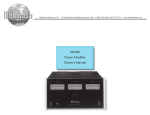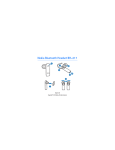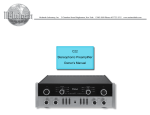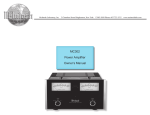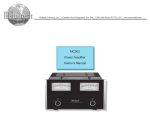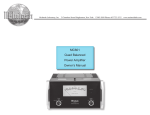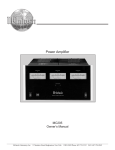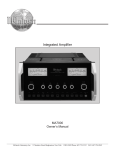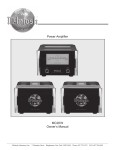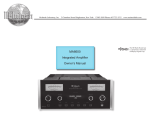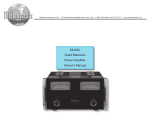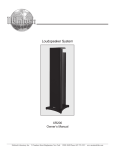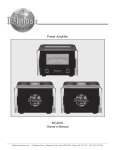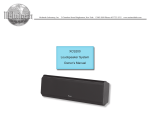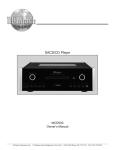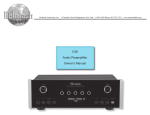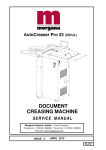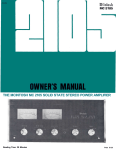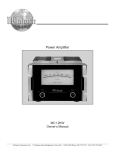Download McIntosh MC303 audio amplifier
Transcript
Power Amplifier MC303 Owner’s Manual McIntosh Laboratory, Inc. 2 Chambers Street Binghamton, New York 13903-2699 Phone: 607-723-3512 www.mcintoshlabs.com The lightning flash with arrowhead, within an equilateral triangle, is intended to alert the user to the presence of uninsulated “dangerous voltage” within the product’s enclosure that may be of sufficient magnitude to constitute a risk of electric shock to persons. WARNING - TO REDUCE RISK OF FIRE OR ELECTRICAL SHOCK, DO NOT EXPOSE THIS EQUIPMENT TO RAIN OR MOISTURE. IMPORTANT SAFETY INSTRUCTIONS! PLEASE READ THEM BEFORE OPERATING THIS EQUIPMENT. 1. Read these instructions. 2. Keep these instructions. 3. Heed all warnings. 4. Follow all instructions. 5. Do not use this apparatus near water. 6. Clean only with a dry cloth. 7. Do not block any ventilation openings. Install in accordance with the manufacturer’s instructions. 8. Do not install near any heat sources such as radiators, heat registers, stoves, or other apparatus (including amplifiers) that produce heat. 9. Do not defeat the safety purpose of the polarized or grounding-type plug. A polarized plug has two blades with one wider than the other. A grounding type plug has two blades and a third grounding prong. The wide blade or the third prong are provided for your safety. If the provided plug does not fit into your outlet, consult an electrician for replacement of the obsolete outlet. 10. Protect the power cord from being walked on or pinched particularly at plugs, convenience receptacles, and the point where they exit from the apparatus. 2 The exclamation point within an equilateral triangle is intended to alert the user to the presence of important operating and maintenance (servicing) instructions in the literature accompanying the appliance. NO USER-SERVICEABLE PARTS INSIDE. REFER SERVICING TO QUALIFIED PERSONNEL. To prevent the risk of electric shock, do not remove cover or back. No user-serviceable parts inside. 11. Only use attachments/accessories specified by the manufacturer. 12. Use only with the cart, stand, tripod, bracket, or table specified by the manufacturer, or sold with the apparatus. When a cart is used, use caution when moving the cart/apparatus combination to avoid injury from tip-over. 13. Unplug this apparatus during lightning storms or when unused for long periods of time. 14. Refer all servicing to qualified service personnel. Servicing is required when the apparatus has been damaged in any way, such as power-supply cord or plug is damaged, liquid has been spilled or objects have fallen into the apparatus, the apparatus has been exposed to rain or moisture, does not operate normally, or has been dropped. 15. Do not expose this equipment to dripping or splashing and ensure that no objects filled with liquids, such as vases, are placed on the equipment. 16. To completely disconnect this equipment from the a.c. mains, disconnect the power supply cord plug from the a.c. receptacle. 17. The mains plug of the power supply cord shall remain readily operable. 18. Do not expose batteries to excessive heat such as sunshine, fire or the like. Thank You Table of Contents Your decision to own this McIntosh MC303 Power Amplifier ranks you at the very top among discriminating music listeners. You now have “The Best.” The McIntosh dedication to “Quality,” is assurance that you will receive many years of musical enjoyment from this unit. Please take a short time to read the information in this manual. We want you to be as familiar as possible with all the features and functions of your new McIntosh. Safety Instructions.............................................................. 2 Thank You and Please Take a Moment............................... 3 Technical Assistance and Customer Service...................... 3 Table of Contents................................................................ 3 General Information........................................................3-4 Connector Information....................................................... 4 Introduction......................................................................... 4 Performance Features......................................................... 4 Dimensions......................................................................... 5 Installation.......................................................................... 6 Rear Panel Connections and Switch................................... 7 How to Connect............................................................... 8-9 Connection Diagrams (Separate Sheet) MC1A and MC1B Front Panel Displays and Controls.....................................10 How to Operate..................................................................11 Technical Description...................................................12-15 Photos............................................................................16-17 Specifications.....................................................................18 Packing Instruction............................................................19 Please Take A Moment The serial number, purchase date and McIntosh Dealer name are important to you for possible insurance claim or future service. The spaces below have been provided for you to record that information: Serial Number:___________________________________ Purchase Date:_ __________________________________ Dealer Name:_ ___________________________________ Technical Assistance If at any time you have questions about your McIntosh product, contact your McIntosh Dealer who is familiar with your McIntosh equipment and any other brands that may be part of your system. If you or your Dealer wish additional help concerning a suspected problem, you can receive technical assistance for all McIntosh products at: McIntosh Laboratory, Inc. 2 Chambers Street Binghamton, New York 13903 Phone: 607-723-1545 Fax: 607-724-0549 Customer Service If it is determined that your McIntosh product is in need of repair, you can return it to your Dealer. You can also return it to the McIntosh Laboratory Service Department. For assistance on factory repair return procedure, contact the McIntosh Service Department at: McIntosh Laboratory, Inc. 2 Chambers Street Binghamton, New York 13903 Phone: 607-723-3515 Fax: 607-723-1917 General Information Caution: The MC303 Amplifier weight is 150 pounds (70.3 kilograms). It requires two or more persons to safely handle when moving the amplifier. 1. The following Connecting Cable is available from the McIntosh Parts Department: Power Control Cable Part No. 170-202 Six foot, 2 conductor shielded, with two 1/8 inch stereo mini phone plugs. 2. For additional connection information, refer to the owner’s manual(s) for any component(s) connected to the MC303. 3. The MC303 mutes the speaker output for approximately two seconds when first turned on. 4. In the event the MC303 overheats, due to improper ventilation and/or high ambient temperature, the protection circuits will activate. The Front Panel Power Guard LEDs will continuously indicate ON and the audio will be muted. When the MC303 has returned to a safe operating temperature, normal operation will resume. 5. For the best performance it is important to minimize an impedance mismatch. An impedance mismatch can occur when a Loudspeaker of a given impedance rating is connected to the MC303 Output Terminals with a different impedance rating. For example, a Loudspeaker with an impedance rating of 2 Ohms is connected to the MC303 8 Ohm Output Terminals. The impedance of a Loudspeaker actually varies as the Loudspeaker reproduces different frequencies. As a result, the nominal impedance rating of the Loudspeaker (usually measured at a midrange frequency) might not always agree with the impedance of the Loudspeaker at low frequencies where the greatest amount of power is required. Copyright 2008 © by McIntosh Laboratory, Inc. 3 Connector Information, Introduction and Performance Features General Information, con’t 6. When discarding the unit, comply with local rules or regulations. Batteries should never be thrown away or incinerated but disposed of in accordance with the local regulations concerning battery disposal. 7. For additional information on the MC303 and other McIntosh Products please vist the McIntosh Web Site at www.mcintoshlabs.com. 8. When the MC303 is operated in the USA or Canada and the main fuse, located on the rear panel, is in need of replacement use only the following part: Bussman ABC-15-R or Littlefuse 314-015P Connector and Cable Information XLR Connectors Below is the Pin configuration for the XLR Balanced Input Connectors on the MC303. Refer to the diagram for connection: PIN 1: Shield/Ground PIN 2: + Output PIN 3: - Output PIN 2 PIN 1 PIN 3 Power Control Connector The MC303’s Power Control Inputs receive On/Off signals of +5 volts. An additional connection Power is for controlling the illumination of Control the MC303 Power Output Meters. Meter The 1/8 inch stereo mini phone plug Illumination Control connects to a McIntosh A/V Control Ground Center Power Control Output. Note: The Power Control Connecting Cable is available from the McIntosh Parts Department: Data and Power Control Cable Part No. 170-202 Six foot, shielded 2 conductor, with 1/8 inch stereo mini phone plugs on each end. Introduction Now you can take advantage of traditional McIntosh standards of excellence in the MC303 Power Amplifier. The 300 watt high current output per channel will drive any high quality loudspeaker system to its ultimate performance. The MC303 reproduction is sonically transparent and absolutely accurate. The McIntosh Sound is “The Sound of the Music Itself.” Performance Features • Power Output The MC303 is a Power Amplifier with a capability of 300 watts per channel (all channels driven) into 2, 4 or 8 ohm speakers with less than 0.005% distortion. The Power Am4 plifier circuitry uses Thermal Trak1 Output Transistors for lower distortion and cool operation. • Balanced and Unbalanced Inputs Balanced connections guard against induced noise and allow long cable runs without compromising sound quality. • Power Guard The patented McIntosh Power Guard circuit prevents the amplifier from being over driven into clipping, with its harsh distorted sound that can also damage your valuable loudspeakers. • Sentry Monitor and Thermal Protection McIntosh Sentry Monitor power output stage protection circuits ensure the MC303 will have a long and trouble free operating life. Built-in Thermal Protection Circuits guard against overheating. • Patented Autoformer McIntosh designed and manufactured Output Autoformers provide an ideal match between the amplifier output stages and speaker loads of 2, 4 and 8 ohms. The Autoformers also provide perfect DC protection for your valuable loudspeakers. • Special Power Supply A regulated Power Supply, a very large Power Transformer and Capacitors ensure stable noise free operation even though the power line varies. • Illuminated Power Meter The Illuminated Power Output Watt Meter on the MC303 is peak responding, and indicates the power output of the amplifier. The Front Panel Meter Illumination may be switched Off at any time. • Fiber Optic Solid State Front Panel Illumination The even illumination of the Front Panel is accomplished by the combination of custom designed Fiber Optic Light Diffusers and extra long life Light Emitting Diodes (LEDs). • Glass Front Panel and Super Mirror Chassis Finish The famous McIntosh Illuminated Glass Front Panel and the Stainless Steel Chassis with Super Mirror Finish ensures the pristine beauty of the MC303 will be retained for many years. 1 ThermalTrak™ and ON Semiconductor are trademarks of Semiconductor Components Industries, LLC Dimensions Dimensions The following dimensions can assist in determining the best location for your MC303. There is additional information on the next page pertaining to installing the MC303 into cabinets. 17-3/4" 45.09cm 10-7/8" Front View of the MC303 27.62cm 12-3/8" 31.43cm 17-3/8" 44.15cm Rear View of the MC303 F15AH 125V 12-1/4" 31.11cm 19-1/2" 49.50cm 18" 1-5/8" 45.72cm 4.12cm Side View of the MC303 3/16" 0.48cm 1-1/2" 3.81cm 14" 35.60cm 10-1/2" 26.70cm 1-9/16" 3.96cm 5 Installation Installation sure to cut out a ventilation hole in the mounting shelf acThe MC303 can be placed upright on a table or shelf, cording to the dimensions in the drawing. standing on its four feet. It also can be custom installed in a piece of furniture or cabinet of your choice. The four feet 1 When the MC303 is installed together with other McIntosh may be removed from the bottom of the MC303 when it is Components, check clearances on all components before custom installed as outlined below. The four feet together proceeding. with the mounting screws should be retained for possible future use if the MC303 is removed from the custom 17-9/16" installation and used free 44.62cm standing. The required panel cutout, ventilation cutout and unit dimensions are shown. Always provide adequate 10 -13/16" MC303 Front Panel ventilation for your 27.46cm Custom Cabinet Cutout MC303. Cool operation ensures the longest possible operating life for any electronic instrument. Do not install the MC303 directly above a heat generating component such as a 6" high powered amplifier. If Cabinet 15.24cm Cutout Opening for Custom Mounting Front all the components are inPanel stalled in a single cabinet, a quiet running ventilation fan can be a definite Opening for Ventilation asset in maintaining all the system components at the coolest possible operating temperature. A custom cabinet instalMC303 Side View in Custom Cabinet lation should provide the following minimum spacChassis Spacers ing dimensions for cool operation. Cutout Opening for Ventilation Allow at least 6 inches (15.24cm) above the top, Support 1" 2 inches (5.08cm) below Shelf 2.54cm the bottom and 1 inch (2.54cm) on each side of the Power Amplifier, so that airflow is not ob14-1/2" 36.83cm 21/32" structed. Allow 19-1/2 MC303 Bottom View 1.67cm 15-5/16" 14" inches (49.53cm) depth in Custom Cabinet 38.91cm Cutout Opening 35.56cm behind the front panel. for Ventilation Allow 1-5/8 inch (4.12cm) in front of the mounting Note: Center the cutout Horizontally on the unit. panel1 for clearance. Be For purposes of clarity, the above illustration is not drawn to scale. 6 Rear Panel Connections and Switch UNBALANCED INPUT 3 for an audio cable from an A/V Control Center or Preamplifier audio output POWER CONTROL IN receives turn On/Off signal from a McIntosh component and the POWER CONTROL OUT sends a turn On/Off signal to the next McIntosh Component BALANCED INPUT 3 for an audio cable from an A/V Control Center or Preamplifier audio output BALANCED INPUT 2 for an audio cable from an A/V Control Center or Preamplifier audio output UNBALANCED INPUT 2 for an audio cable from an A/V Control Center or Preamplifier audio output BALANCED INPUT 1 for an audio cable from an A/V Control Center or Preamplifier audio output UNBALANCED INPUT 1 for an audio cable from an A/V Control Center or Preamplifier audio output F15AH 125V OUTPUT 3 Connections for 2 ohm, 4 ohm or 8 ohm Loudspeaker OUTPUT 2 Connections for 2 ohm, 4 ohm or 8 ohm Loudspeaker Connect the MC303 power cord to a live AC outlet. Refer to the rear panel to determine the correct voltage OUTPUT 1 Connections for 2 ohm, 4 ohm or 8 ohm Loudspeaker Main Fuse holder, refer to information on the back panel of your MC303 to determine the correct fuse size and rating. When used in the USA and Canada refer to General Information note number 8 on page 4. 7 How to Connect for Center and Surround Channels Caution: The supplied AC Power Cord should not be connected to the Rear Panel of the MC303 Amplifier until after the Loudspeaker Connections have been made. Failure to observe this could result in Electric Shock. For additional instruction on making Loudspeaker Connections contact your McIntosh Dealer or McIntosh Technical Support. The connection instructions below, together with the MC303 Connection Diagram located on the separate folded sheet “Mc1A, is an example of a typical audio/video system. Your system may vary from this, however the actual components would be connected in a similar manner. For additional information refer to “Connector and Cable Information” on page 4. 1. For Remote Power Control, connect a power control cable from the A/V Control Center or Preamplifier Power Control Out to the Right Front Channel Power Amplifier Power Control In. Connect a second power control cable from the Right Front Channel Power Amplifier Power Power Control Out to the Left Front Channel Power Amplifier Power Control In. 2. Connect a power control cable from the Left Front Channel Power Amplifier Power Power Control Out to the MC303 POWER CONTROL IN. 3. Connect cables from the Balanced Outputs of the A/V Control Center or Preamplifier (Left and Right Front Channels) to the Left and Right Front Power Amplifiers. Note: An optional hookup is to use the UNBALanced INPUTS with unbalanced cables instead of balanced. However, both type of connections for a given Input should not be used at the same time. 4. Connect cables from the Balanced Outputs of the A/V Control Center or Preamplifier (Center and Surround Channels) to the MC303 BALANCED INPUTs (1-3). When connecting Loudspeakers to the MC303 it is very important to use cables of adequate size, so there is little to no power loss in the cables. The size is specified in Gauge Numbers or AWG (American Wire Gauge). The smaller the Gauge number, the larger the wire size: Loudspeaker Cable Distance vs Wire Gauge Guide Loudspeaker Impedance 25 feet (7.62 meters) or less 50 feet (15.24 meters) or less 100 feet (30.48 meters) or less 2 Ohms 12AWG 10AWG 8AWG 4 Ohms 14AWG 12AWG 10AWG 8 Ohms 16AWG 14AWG 12AWG 5. This McIntosh MC303 Power Amplifier is designed for 8 the connection of a single Loudspeaker per amplifier channel, with an impedance of 2 ohms, 4 ohms or 8 ohms. Note: The remaining Amplifier Loudspeaker Terminals should not be connected to another Loudspeaker. 6. Prepare the Loudspeaker Hookup Cables that attach to the Amplifier by choosing one of the methods below: Bare wire cable ends: Carefully remove sufficient insulation from the cable ends, refer to figures 1, 2 & 3. If the cable is stranded, carefully twist the strands together as tightly as possible. Figure 2 Figure 3 Figure 1 Note: If desired, the twisted ends can be tinned with solder to keep the strands together, or attach spade lug and/or banana connector. Spade lug or prepared wire connection: Insert the spade lug connector or prepared section of the cable end into the terminal side access hole, and tighten the terminal cap until the cable is firmly clamped into Figure 4 Figure 5 Figure 6 the terminal so the wires cannot slip out. Refer to figures 4, 5 & 6. Banana plug connection: Insert the banana plug into the hole at the top of the terminal. Refer to figures A and B. Note: Banana Plugs are for use in the United States and Canada only. 7. Connect the Loudspeaker hookup cables from a single Loudspeaker to the output terminals that match the impedance of OUPUT 1, being careful to observe the correct polarities. Output impedance connections of 2 ohms, 4 ohms and 8 ohms are provided. If the Loudspeaker’s impedance is in-between the available connections, use the nearest lower impedance connection. Refer to “General Information” Note 5 on page 3 for additional information. WARNING: Loudspeaker terminals are hazardous live and present a risk of electric shock. 8. In a similar manner, connect a Loudspeaker to OUTPUT 2 and connect the remaining Loudspeaker to OUTPUT 3. 9. Connect the MC303 Power Cord to a live AC outlet. How to Connect How to Connect for Left, Center and Right Channels Caution: The supplied AC Power Cord should not be connected to the Rear Panel of the MC303 Amplifier until after the Loudspeaker Connections have been made. Failure to observe this could result in Electric Shock. For additional instruction on making Loudspeaker Connections contact your McIntosh Dealer or McIntosh Technical Support. The connection instructions below, together with the MC303 Connection Diagram located on the separate folded sheet “Mc1B, is an example of a typical audio/video system. Your system may vary from this, however the actual components would be connected in a similar manner. For additional information refer to “Connector and Cable Information” on page 4. 1. For Remote Power Control, connect a power control cable from the A/V Control Center or Preamplifier Power Control Out to the MC303 POWER CONTROL IN. 2. Connect a second power control cable from the MC303 POWER CONTROL OUT to the Left and Right Surround Channel Power Amplifier Power Control In. 3. Connect cables from the Balanced Outputs of the A/V Control Center or Preamplifier (Left, Center and Right Front Channels) to the MC303 BALANCED INPUTs (1-3). Note: An optional hookup is to use the UNBALanced INPUTS with unbalanced cables instead of balanced. However, both type of connections for a given Input should not be used at the same time. 4. Connect cables from the Balanced Outputs of the A/V Control Center or Preamplifier (Surround Channels) to the Left and Right Surround Channel Power Amplifier. When connecting Loudspeakers to the MC303 it is very important to use cables of adequate size, so there is little to no power loss in the cables. The size is specified in Gauge Numbers or AWG (American Wire Gauge). The smaller the Gauge number, the larger the wire size: Loudspeaker Cable Distance vs Wire Gauge Guide Loudspeaker Impedance 25 feet (7.62 meters) or less 50 feet (15.24 meters) or less 100 feet (30.48 meters) or less 2 Ohms 12AWG 10AWG 8AWG 4 Ohms 14AWG 12AWG 10AWG 8 Ohms 16AWG 14AWG 12AWG 5. This McIntosh MC303 Power Amplifier is designed for the connection of a single Loudspeaker per amplifier channel, with an impedance of 2 ohms, 4 ohms or 8 ohms. Note: The remaining Amplifier Loudspeaker Terminals should not be connected to another Loudspeaker. 6. Prepare the Loudspeaker Hookup Cables that attach to the Amplifier by choosing one of the methods below: Bare wire cable ends: Carefully remove sufficient insulation from the cable ends, refer to figures 1, 2 & 3. If the cable is stranded, carefully twist the strands together as tightly as possible. Note: If desired, the twisted ends can be tinned with Figure 2 Figure 3 Figure 1 solder to keep the strands together, or attach spade lug and/or banana connector. Spade lug or prepared wire connection: Insert the spade lug connector or prepared section of the cable end into the terminal side access hole, and tighten the terminal cap until the cable is firmly clamped into the terminal so the wires cannot slip out. Refer Figure 4 Figure 5 Figure 6 to figures 4, 5 & 6. Banana plug connection: Insert the banana plug into the hole at the top of the terminal. Refer to figures A and B. Note: Banana Plugs are for use in the United States and Canada only. 7. Connect the Loudspeaker hookup cables from a single Loudspeaker to the output terminals that match the impedance of OUPUT 1, being careful to observe the correct polarities. Output impedance connections of 2 ohms, 4 ohms and 8 ohms are provided. If the Loudspeaker’s impedance is in-between the available connections, use the nearest lower impedance connection. Refer to “General Information” Note 5 on page 3 for additional information. WARNING: Loudspeaker terminals are hazardous live and present a risk of electric shock. 8. In a similar manner, connect a Loudspeaker to OUTPUT 2 and connect the remaining Loudspeaker to OUTPUT 3. 9. Connect the MC303 Power Cord to a live AC outlet. 9 Front Panel Displays and Switches Meters indicate the Amplifier Power Output of Channels 1-3 LEDs indicate when Amplifier Channels 1-3 POWER GUARD circuits activate Standby Power On Indicator METER Switch selects Meter Illumination Auto (On) or Off 10 POWER Switch Turns AC Power On/Off, or On/Remote How to Operate How to Operate Power On To have the MC303 automatically turn On or Off when an A/V Control Center or Preamplifier turns on or off, rotate the power switch to the REMOTE position. For manual operation, rotate the power switch to the ON or OFF position as desired. Refer to figure 8. Note: There must be a power control connection between the MC303 and the A/V Control Center or Preamplifier, in order for the remote power turn-on to function. Power Guard During normal operation, the Front Panel Power Guard Indicators will momentarily illuminate during peaks in the audio signals. Refer to figure 11. In the event the MC303 overheats, due to improper ventilation and/or high ambient temperature, the internal Figure 11 protection circuits will activate. The Front Panel Power Guard Indicators will continuously illuminate and the audio will be muted. When the MC303 has returned to a safe operating temperature, normal operation will resume. Figure 8 Meters Rotate the METER LIGHTS Switch to select the Meter Illumination Mode you desire. Refer to figure 9. OFF - Meter Illumination is switched OFF and the meters will continue to indicate the power output. AUTO - Meter Illumination is switched ON. When Power Control Input of the MC303 is connected to an A/V Control Center Figure 9 or Preamplifier with Remote Meter Illumination Control, the Meter Illumination will automatically be remotely controlled (On/Off). The MC303 Meters respond to all the musical information being produced by the three Power Amplifier Circuits. Refer to figure 10. They indicate to an accuracy of at least 95% of the power output with only a single cycle of a 2000Hz tone burst. Figure 10 11 Technical Description McIntosh Laboratory, the company who introduced the world’s first amplifier that could be called “High Fidelity”, has done it again. The McIntosh engineering staff has created a power amplifier without compromise, using the most advanced McIntosh circuit design concepts. A continuous average power output rating of 300 watts per channel and with an output current of greater than 60 amperes per channel, making this one of the most advanced and powerful amplifiers McIntosh has ever manufactured. The distortion limits for the MC303 are no more than 0.005% at rated power output for all frequencies from 20Hz to 20,000Hz. Typical performance at mid frequencies is less than 0.0002%. The true distortion readings on the MC303 are so low, it takes special measuring techniques to make accurate readings. The MC303 can deliver the best possible performance from any type of high quality loudspeaker system. Creating an amplifier with this level of performance did not come easily. Many months of design, testing and measuring were required. Extensive controlled listening tests, the ultimate form of measuring, were made before the final design was accepted. Inside Bottom View of the MC303 12 Technical Description POSITIVE SENTRY MONITOR Power Amplifier Block Diagram THERMAL TRAK DC BIAS com (one channel shown) NEGATIVE SENTRY MONITOR BALANCED AMP Figure 12 Design Philosophy The design philosophy incorporated in the MC303 involved several different techniques, all based on sound scientific logic. Refer to figure 12. Every stage of voltage or current amplification must be as linear as possible prior to the use of negative feedback. McIntosh engineers know how to properly design negative feedback circuits so they contribute to the extremely low distortion performance expected from a McIntosh amplifier. The typical McIntosh owner would never accept the approximately 100 times higher distortion of many non-feedback designs. All transistors are selected to have nearly constant current gain over the entire current range they must cover. The 12 Power Transistors used in each channel of the MC303 Power Output Circuitry, have matched uniform current gain, high current bandwidth product and a large active region safe operating area. Refer to figure 13. These Power Transistors are the very latest in semiconductor technology Figure 13 and incorporate a new design known as ThermalTrak™. Refer to figure 14. This allows for the instantaneous and accurate monitoring of the Power Transistor Temperature. The MC303 Power Output Circuitry has a specially designed bias circuit to take full advantage of the ThermalTrak™ Power Transistors and thus precisely controls the power amplifier operation over a wide Figure 14 range of music conditions with the benefits of lower distortion and cooler operation. The MC303 can provide greater than 60 amperes peak output current to drive uneven speaker loads. Some poor speaker designs have input impedance that dip to 1 or 2 ohms at various frequencies and the MC303 has the output current reserve to drive them. The high efficiency circuit design of the MC303 contributes to low operating temperatures. More than 2,100 square inches of heat sink area keep the MC303 operating safely with convection cooling. No fans are needed. Precision metal film resistors and low dielectric absorption film capacitors are used in all critical circuit locations. Autoformers The output signal of the MC303 Power Amplifier Circuitry is coupled to the Loudspeaker via the unique McIntosh Output Autoformer. Refer to figure 15. The unequaled expertise of McIntosh in the design and manufacturing of autoformers is legendary in the high fidelity industry. All solid state power amplifier output circuits work best into Figure 15 what is called an optimum load. This optimum load may vary considerably from what a loudspeaker requires. In the case of more than one Loudspeaker connected in parallel, the load to the power amplifier may drop to two ohms or even less. A power amplifier connected to a load that is lower than optimum, causes more output current to flow, which results in extra heat being generated in the power output stage. This 13 increase in temperature will result in a reduced life expectancy for the amplifier. The Autoformer creates an ideal match between the Power Amplifier Output Circuitry and the Loudspeaker. There is absolutely no performance limitation with an Autoformer. Its frequency response from below 20Hz to well beyond 20,000Hz exceeds the Power Output Circuitry Frequency Response, and extends well beyond the audible range. Its distortion level is so low it is virtually impossible to measure. In the rare event of a power amplifier output circuit failure, the McIntosh Autoformer provides absolute protection from possible damage to your valuable Loudspeakers. Protection Circuits The different types of protection circuits incorporated in the MC303 insure a long and safe operating life. The MC303 incorporates the McIntosh Sentry Monitor output transistor protection circuit. Refer to figure 16. There is absolutely no compromise in sonic performance with this circuit, and it ensures safe operation of the amplifier under even the most extreme opNormal erating conditions. Operating Area The MC303 also includes the unique patented McIntosh Sentry Monitor Safety Area Power Guard Circuit. Power Guard elimiOutput Transistor Failure nates the possibility of ever overdriving Figure 16 the amplifier into clipping. Refer to figures 17, 18 and 19. An overdriven amplifier can produce both audible and inaudible distortion levels exceeding 40%. The audible distortion is unpleasant to hear, but the inaudible ultrasonic distortion is also undesirable, since it can Input Test Signal damage valuable loudspeaker system tweeters. You will never experience the harsh and damaging distortion due to clipping. The Power Guard circuit is a waveform comparator, monitoring both the input and output waveforms. Under normal operating conditions, there are no differences between Figure 17 14 the shape of these waveforms. If an amplifier channel is overdriven, there will be a difference between the two signal waveforms. When the difference exceeds 0.3% the Power Guard activates the PG light and a dynamic electronic attenuator at the amplifier input reduces the input volume just enough to prevent any further increase in distortion. The Power Guard circuit acts so fast that there are absolutely no audible side effects and the sonic purity of the music reproduction is perfectly preserved. The MC303 Power Amplifier with Power Guard is not limited to just the rated power output, but will actually produce distortion free output well above its rated power due to the McIntosh philosophy of conservative design. Without Power Guard Figure 18 With Power Guard Figure 19 Power Supply Circuits To compliment the design of the MC303 Power Amplifier Circuitry, there is a high current high voltage power supply for the three channels. Refer to figure 20 on page 15. The power amplifiers draw high current from the AC power line. Therefore, it is important that they plug directly into the wall outlet. The MC303 incorporates a very large high current Main Power Transformer. Refer to figure 21. It is enclosed in the legendary McIntosh Potted Enclosures and weighs 38 lbs. The super size multiple large main filter capacitors Figure 21 Technical Description, con’t Power Supply Block Diagram STANDBY TRANSFORMER STANDBY SUPPLY Figure 20 can store over 200 Joules of energy, for the three amplifier channels, necessary for the wide dynamic range “Digital Audio” demands. Refer to figure 22. Figure 22 There is also a fully regulated low voltage power supply to guarantee excellent signal to noise ratio. Refer to figure 22. Also, most owners desire one power switch for the whole audio system. The MC303 is equipped with a circuit that provides remote Power Control from a McIntosh A/V Control Center. When the A/V Control Center is switched On, a (+5V) signal operates the power relay in the MC303. The MC303 also has a remote Power Control Out Jack. The Power Control signal from this jack is delayed by a fraction of a second so that the turn on power surge of the next power amplifier occurs at a later time. This helps prevent power circuit overload that could trip circuit breakers or blow fuses, a very important feature in a high power Home Theater System employing multiple Power Amplifiers. 15 Top View of the MC303 16 Photos Angle View of the MC303 Rear View of the MC303 17 Specifications Specifications Power Output Minimum sine wave continuous average power output per channel, all channels operating: 300 watts into a 2 ohm, 4 ohm or 8 ohm load Output Load Impedance 2, 4 or 8 ohms Rated Power Band 20Hz to 20,000Hz Total Harmonic Distortion 0.005% maximum harmonic distortion at any power level from 250 milliwatts to rated power, 20Hz to 20,000Hz Dynamic Headroom 1.8dB Frequency Response +0, -0.25dB from 20Hz to 20,000Hz +0, -3dB from 10Hz to 100,000Hz Input Sensitivity (for rated output) 1.7 Volt Unbalanced 3.4 Volt Balanced Signal To Noise Ratio (A-Weighted) 112dB below rated output Intermodulation Distortion 0.005% maximum, if the instantaneous peak power output does not exceed twice the rated power output for any combination of frequencies from 20Hz to 20,000Hz. Wide Band Damping Factor Greater than 40 Input Impedance 10,000 ohms Power Guard Less than 2% THD with up to 14dB overdrive at 1,000Hz Power Control Input 5VDC - 12VDC Power Control Output 12VDC, 25mA maximum, delay 0.2 seconds 18 Power Requirements 100 Volts, 50/60Hz at 12 Amps 110 Volts, 50/60Hz at 11 Amps 120 Volts, 50/60Hz at 10 Amps 220 Volts, 50/60Hz at 6 Amps 230 Volts, 50/60Hz at 6 Amps 240 Volts, 50/60Hz at 6 Amps Standby: Less than 1 watt Note: Refer to the rear panel of the MC303 for the correct voltage. Overall Dimensions Width is 17-3/4 inches (45.09cm) Height is 12-3/8 inches (31.43cm) including feet Depth is 22 inches (55.88cm) including the Front Panel and Cables Weight 155 pounds (70.3 kg) net, 180 pounds (81.6 kg) in shipping carton Shipping Carton Dimensions Width is 31 inches (78.74cm) Depth is 28 inches (71.12cm) Height is 17-1/4 inches (43.82cm) Packing Instructions Packing Instructions In the event it is necessary to repack the equipment for shipment, the equipment must be packed exactly as shown below. It is very important that the four feet are attached to the bottom of the equipment. This will ensure the proper equipment location on the bottom foam pad. Failure to do this will result in shipping damage. Use the original shipping carton and interior parts only if they are all in good serviceable condition. If a shipping carton or any of the interior part(s) are needed, please call or write Customer Service Department of McIntosh Laboratory. Please see the Part List for the correct part numbers. Quantity 1 1 2 3 Part Number 034105 034104 034439 034441 4 018445 Description Shipping carton top Shipping carton bottom Foam Pad (top and bottom) Foam Ring Feet 19 McIntosh Laboratory, Inc. 2 Chambers Street Binghamton, NY 13903 www.mcintoshlabs.com The continuous improvement of its products is the policy of McIntosh Laboratory Incorporated who reserve the right to improve design without notice. Printed in the U.S.A. McIntosh Part No. 04109800




















